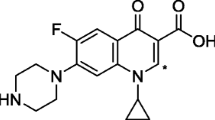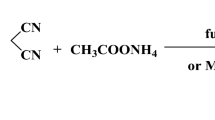Abstract
Ab Initio, molecular orbital methods are being used to analyze and interpret structure-activity relationships in anti-inflammatory phenols, benzoates and salicylates. The results show a correlation between the potency of the active compounds as inhibitors of prostaglandin production in cell cultures and the orbital energy of the highest occupied molecular orbital with a correlation coefficient ofr ∼ 0.8.
The mode(s) of action and structural requirements of anti-inflammatory, non-narcotic analgesics continues to defy rationalization. Even the most plausible proposed molecular mechanism of their anti-inflammatory action, i.e., inhibition of prostaglandin biosynthesis [1], is still subject to controversy [2, 3]. Therefore other approaches may be fruitful for relating the NSAID's biological activity to molecular structure and properties.
One such approach is to relate the biological activity to structural indices obtained from molecular orbital theory. From the results of such quantum chemical calculations it is hoped that deeper insight can be obtained into the NSAID's mode(s) of action by evaluating their dependance on the electronic structure of the biologically active species. A complicating factor in the present studies is that the existence of a specific receptor has not yet been firmly established.
For the present work biological activity is defined as the potency of the given compound to inhibit the 12-O-tetradecanoylphorbol-13-acetate (TPA) induced PGE2 release from macrophages isolated from the peritoneum of young male NMRI mice. For methodological details see Ref. [4].
From about 80 compounds which have been assayed a sample of 30 molecules was selected for quantum chemical study. The sample comprises phenol, benzoic acid, and salicylic acid and their hydroxy, fluoro- and chloro congenrs. All calculations were carried out usingab initio molecular orbital methods with programs developed in this laboratory.
The σ and π orbital energies of the highest occupied molecular orbital (HOMO) and lowest unoccupied molecular orbital (LUMO) were analyzed for correlation with the potency of 18 (or 17) active molecules. As the correlation coefficients in Table 1 show, the π-HOMO orbital energies exhibit a significant correlation with the pIC50's, whereas the σ-HOMO and the LUMO orbital energies do not. The observed correlation shows that potency increases with increasing π-HOMO orbital energy, i.e., weaker binding of the π-HOMO electrons, which enhances the potential for interaction with specific or non-specific interaction sites.
Examination of the correlations reported in Table 1 suggests that the first and second row substituents correlate similarly with the π-HOMO orbital energy, but that the second row group is displaced from the first row group. Separate analysis of the two groups is also given in Table 1. These latter correlation coefficients are about 10% higher than for the whole sample. It is noteworthy that for the other orbital energies the single group correlation coefficients can also be quite high, but that the combined correlation is small to completely random.
Three models have been proposed for the cyclooxygenase receptor where the NSAID's carry out their purported inhibitory function [5–7]. Although these models differ considerably in their details, all three include a π-electron interaction (acceptor) region. The present results support the need for such a region and suggest that enhanced ability to donate π-electrons helps increase potency in inhibiting the release of PGE2 in macrophages.
A detailed report of this work will be given elsewhere.
Similar content being viewed by others
References
J.R. Vane,Inhibition of prostaglandin synthesis as a mechanism of action for aspirin-like drugs, Nature New Biol.231, 232–235 (1971).
M.J.H. Smith,Aspirin and prostaglandins: Some recent developments. Agents and Actions8, 427–429 (1978).
J.R. Vane,The mode of action of aspirin-like drugs, Agents and Actions8, 430–431 (1978).
K. Brune, K.D. Rainsford, K. Wagner andB.A. Peskar,Inhibition by anti-inflammatory drugs of prostaglandin production in cultured macrophages, Arch. Pharm.315, 269–276 (1981).
R.A. Scherrer, inAntiinflammatory Agents: Chemistry and Pharmacology, vol. 1, pp. 29–43 (Eds.R.A. Scherrer andM.W. Whitehouse). Academic Press, New York, N.Y. 1974.
P. Gund andT.Y. Shen,A model for the prostaglandin synthetase cyclooxygenation site and its inhibition by antiinflammatory arylacetic acids, J. Med. Chem.20, 1146–1152 (1977).
R.A. Appleton andK. Brown,Conformational requirements at the prostaglandin cyclooxygenase receptor site, Prostaglandins18, 29–32 (1979).
Author information
Authors and Affiliations
Rights and permissions
About this article
Cite this article
Mehler, E.L., Habicht, J. & Brune, K. Structure-activity relationships in anti-inflammatory phenols, benzoates, and salicylates as obtained by quantum chemical methods. Agents and Actions 13, 516–517 (1983). https://doi.org/10.1007/BF02176434
Issue Date:
DOI: https://doi.org/10.1007/BF02176434




